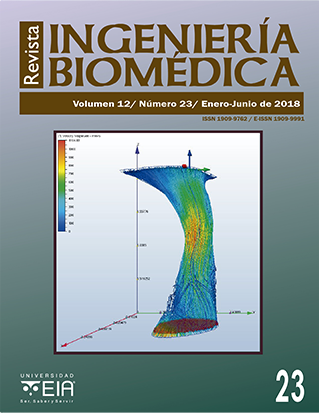Caracterización de matrices de Polivinil alcohol-Alginato-Quitosano-Aloe vera
Caracterización de matrices de Polivinil alcohol-Alginato-Quitosano-Aloe vera
Barra lateral del artículo
Licencia
![]()
Esta obra está bajo una Licencia Creative Commons Atribución-NoComercial-NoDerivativa 4.0 Internacional
Contenido principal del artículo
Resumen
El objetivo de este trabajo fue obtener un sistema que pueda ser usado para conservar de manera localizada en una herida dérmica las propiedades cicatrizantes y refrescantes del Aloe Vera usado en la medicina tradicional, integrando dicho principio activo en una matriz polimérica compuesta por alginato, quitosano y alcohol polivinílico (PVA), los cuales en conjunto poseen propiedades de resistencia mecánica, biodegradabilildad y biocompatibilidad, necesarios para este tipo de aplicación. Para llevar a cabo esta investigación, se evaluó la morfología, grupos funcionales, propiedades mecánicas y cinética de liberación de las muestras. Cada una de las matrices evidenciaron una morfología con poros interconectados y estabilidad mecánica. La liberación de Aloe vera desde la matriz de PVA-alginato-quitosano tuvo un comportamiento no fickiano, mientras la de alginato-quitosano siguió un comportamiento más cercano al fickiano. Las matrices de PVA-quitosano-alginato y alginato- quitosano por sus características, mecánicas, morfológicas de poros definidos e interconectados, y de cinética de liberación representan buenos modelos para ser tenidos en cuenta como sistemas de liberación controlada de medicamentos.
Descargas
Detalles del artículo
Referencias (VER)
Chi Leung-Hi P, Weng Y. W, Frency Sau-Fu Ng, et. al. “Preparation and characterization of chitosan/sodium alginate (CSA) microcapsule containing Cortex Moutan,” Colloids Surfaces A Physicochemistry, 434 (5), pp. 95–101, 2013.
Femenia A, Sánchez E. S, Simal. S, and Rosselló. C, “Compositional features of polysaccharides from Aloe vera (Aloe barbadensis Miller) plant tissues,” Carbohydrate Polymers, 39, pp. 109–117, 1999.
Rodríguez. G. V,. Femenia. A, González .R. F, Rocha. N. E, Gallegos. J. A, M. Candelas. G , Ramírez-Baca. P, Simal. S, and Rosselló. C, “Effects of pasteurization on bioactive polysaccharide acemannan and cell wall polymers from Aloe barbadensis Miller,” Carbohydrate Polymers, 86. pp. 1675–1683, 2011.
Ray. A and Aswatha. S. M, “An analysis of the influence of growth periods on physical appearance, and acemannan and elemental distribution of Aloe vera L. gel,” Industrial Crops Products, 48, pp. 36–42, 2013.
Pal K., Paulson. A, and Rousseau. D, “Biopolymers in Controlled-Release Delivery Systems,” Modern Biopolymer Sciencie, pp. 519–557, 2009.
Jen Ming Yang. H. T, “Properties of chitosan containing PP-g-AA-g-NIPAAm bigraft nonwoven fabric for wound dressing.,” Journal of Membrane Sciencie., vol. 243, pp. 1–7, 2004.
Jayakumar R, Prabaharan M, , Sudheesh. K. P, “Biomaterials based on chitin and chitosan in wound dressing applications,” Biotechnology. Adv, 29, pp. 322–337, 2011.
Thu H. E, M. Zulfakar H, and Ng S.F, “Alginate based bilayer hydrocolloid films as potential slow-release modern wound dressing,” International Journal of Pharmaceutics, 434. pp. 375–383, 2012.
Cristina. A, Aránzazu. Z, Lanao. J.M, “Critical factors in the release of drugs from sustained release hydrophilic matrices,” Journal Control. Release, 154, pp. 2–19, 2011.
Nor. A. M, Mohd. S.S, “Development and modification of PVA–alginate as a suitable immobilization matrix.,” Process Biochemistry., 46, pp. 2122–2129, 2011.
Sankalia. M.G,.Mashru. R.C, Sutariya V.B, “Reversed chitosan–alginate polyelectrolyte complex for stability improvement of alpha-amylase: Optimization and physicochemical characterization,” European Journal of Pharmaceutics and Biopharmaceutics, 65(2), pp215-232, 2007.
Lawrie. G, Keen I, Drew. B, Chandler-Temple. A, Rintoul. L, Fredericks. P, and Grøndahl. L, “Interactions between alginate and chitosan biopolymers characterized using FTIR and XPS,” Biomacromolecules, 8, pp. 2533–2541, 2007.
Jen.M.J, Wen. Y.S, Te. L.L, “Evaluation of chitosan/PVA blended hydrogel membranes,” Journal of Membrane Science, 236, pp 39-51, 2004.
Ngoc-Thang. N, Jui-Hsiang. L, “Fabrication and characterization of poly(vinyl alcohol)/chitosan hydrogel thin films via UV irradiation,” European Polymeric. Journal, 49, pp. 4201–4211, 2013.
Silva. S.S, Popa. E.G, Gómes. M.E,“An investigation of the potential application of chitosan/aloe-based membranes for regenerative medicine, Acta Biomaterialia, 9(6), pp 6790-6797,2013.
D. V. Rúben Pereira, Anabela Carvalho, “Development of novel alginate based hidrogel films for wound healing applications,” Int. J. Biol. Macromol., vol. 52, pp. 221–230, 2013.
K. M. R. H.M.P. Naveen Kumara, M.N. Prabhakara, C. Venkata Prasada and M. C. S. S. T.V. Ashok Kumar Reddya, K. Chowdoji Raoa, “Compatibility studies of chitosan/PVA blend in 2% aqueous acetic acid solution at 30°C,” Carbohydr. Polymer, vol. 82, pp. 251–255, 2010.
S. H. G. Jeffrey A. Hinkley, Leslie D. Morgret, “Tensile properties of two responsive hydrogels,” Polymer (Guildf), vol. 45, pp. 8837–8843, 2004.
A. R. Bruno Sarmento, Domingos Ferreira, Francisco Veiga, “Characterization of insulin-loaded alginate nanoparticles produced by ionotropic pre-gelation through DSC and FTIR studies,” Carbohydrate. Polymeric, vol. Vol 66, pp. 1–7, 2006.
P. W. H. Tin Wui Wong, Lai Wah Chan, Shyan Bin Khon, “Design of controlled-release solid dosage forms of alginate and chitosan using microwave,” Journal. Control Release, vol. Vol 4, pp. 99–114, 2002.
Kanti, K. Srigowri, J. Madhuri, B. Smitha, and S. Sridhar, “Dehydration of ethanol through blend membranes of chitosan and sodium alginate by pervaporation,” Separation and Purification Technology, vol. 40. pp. 259–266, 2004.
D. Archana, B. K. Singh, J. Dutta, and P. K. Dutta, “In vivo evaluation of chitosan-PVP-titanium dioxide nanocomposite as wound dressing material, Carbohydrate Polymers; vol 95; pp 530–539, 2013.
J.D Michael, CLH. Nugent. Preparation of a novel freeze thawed poly(vinyl alcohol)composite hydrogel for drug delivery applications. European Journal Pharmacy Biopharmacy.;vol 67; pp :377–386 2007


 PDF
PDF
 FLIP
FLIP







